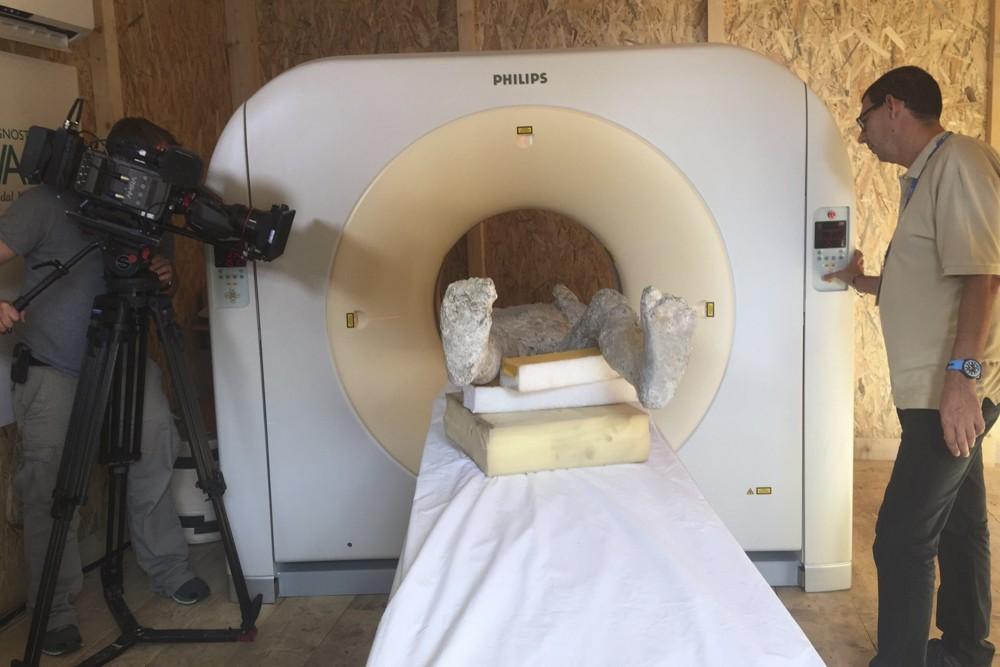Despite the fact that the village of Pompeii was wiped off the face of the Earth nearly 2,000 years ago, it continues to hold the popular imagination in thrall. One reason for that is embodied in a set of 19th century plaster casts that were made of the spaces left in the ash by the bodies of Vesuvius’ victims. These casts, the ultimate in Victorian era macabre, revealed to the public eye the final resting positions of those who died, with a level of detail that transported them from abstract ideas to the physical beings they had once been.
This was possible because while Pompeii had been wiped off the face of the Earth, it still had a presence just below the surface. When the ash and stone rained down on the village in 79 C.E. it not only destroyed their lives, ironically, it also preserved them. In the intervening millennia, much of the ash has been cleared away revealing the art, jewelry, scrolls, and even the food that existed in the village at the time.
Until now, however, researchers had to be content with examining the outside of the antique plaster casts. Current multi-layer CT scanning technology has made it possible to differentiate between the dense plaster of the cast and the fractured skeletons inside of them.
Professor of Classical Studies at Brigham Young University Dr. Roger Macfarlane explained the new view of the past opened up through this application of cutting edge technology:
“Because of careful scholarship, we collectively have been able to get beyond the study of the victim’s death and have opened up exciting information about what the victims’ lives had been like. And, so, any technological development, such as CT scanning of the skeletal remains of those who perished in 79 A.D., promises to introduce potentially interesting new evidence about how those people existed before their death.”
Two discoveries of particular note have resulted from the 3D models. The first is a confirmation of the theory that many of the victims in Pompeii were killed by falling debris rather than suffocation as had long been assumed. The second discovery was that the inhabitants had amazing dental health – and nearly perfect teeth is nothing to sneeze at, especially that long ago.
Another portion of the 3D data gathered was about the plaster casts themselves. The casts are antiques and in their own stages of disrepair. Capturing those casts means that they will be preserved even as their plaster selves give way to the passage of time. 3D models of these casts would allow researchers around the world nearly unlimited access to the information without further damaging either the casts or their contents.
More expert eyes, means more information can be gleaned. Instead of being macabre relics of the past, these plaster creations may only just be beginning to reveal their secrets to us. Let’s hear your thoughts on 3D printing’s role in uncovering details of Pompeii in the Pompeii 3D Printing forum thread on 3DPB.com.
Subscribe to Our Email Newsletter
Stay up-to-date on all the latest news from the 3D printing industry and receive information and offers from third party vendors.
You May Also Like
3D Printing Unpeeled: New Arkema Material for HP, Saddle and Macro MEMS
A new Arkema material for MJF is said to reduce costs per part by up to 25% and have an 85% reusability ratio. HP 3D HR PA 12 S has been...
3D Printing News Briefs, January 20, 2024: FDM, LPBF, Underwater 3D Printer, Racing, & More
We’re starting off with a process certification in today’s 3D Printing News Briefs, and then moving on to research about solute trapping, laser powder bed fusion, and then moving on...
3D Printing Webinar and Event Roundup: December 3, 2023
We’ve got plenty of events and webinars coming up for you this week! Quickparts is having a Manufacturing Roadshow, America Makes is holding a Member Town Hall, Stratafest makes two...
Formnext 2023 Day Three: Slam Dunk
I’m high—high on trade show. I’ve met numerous new faces and reconnected with old friends, creating an absolutely wonderful atmosphere. The excitement is palpable over several emerging developments. The high...


































